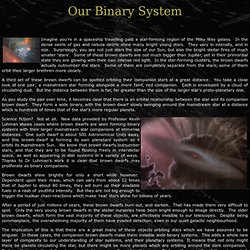

Niburu/Twin Kachina/Nemesis myth and theory. Our binary solar system revealed. Our Binary System Imagine you're in a spaceship travelling past a star-forming region of the Milky Way galaxy.

In the dense swirls of gas and nebula debris shine many bright young stars. They vary in intensity, and in size. Surprisingly, you see not just stars the size of our Sun, but also the bright stellar fires of much smaller 'stars'. Some of these brown dwarfs are not much bigger than Jupiter, yet in their primordial state they are glowing with their own intense red light. A third set of these brown dwarfs can be spotted orbiting their companion stars at a great distance.
As you study the pair over time, it becomes clear that there is an orbital relationship between the star and its companion brown dwarf. Science fiction? Brown dwarfs shine brightly for only a short while however. After a period of just millions of years, these brown dwarfs burn out, and darken. Such a state of affairs would possibly double the number of planets in the Milky Way. Our System This is what you just saw:
Sun has binary partner, may affect the Earth. The ground-breaking and richly illustrated new book, Lost Star of Myth and Time, marries modern astronomical theory with ancient star lore to make a compelling case for the profound influence on our planet of a companion star to the sun.

Author and theorist, Walter Cruttenden, presents the evidence that this binary orbit relationship may be the cause of a vast cycle causing the Dark and Golden Ages common in the lore of ancient cultures. Researching archaeological and astronomical data at the unique think tank, the Binary Research Institute, Cruttenden concludes that the movement of the solar system plays a more important role in life than people realize, and he challenges some preconceived notions: The phenomenon known as the precession of the equinox, fabled as a marker of time by ancient peoples, is not due to a local wobbling of the Earth as modern theory portends, but to the solar system's gentle curve through space. Source: Binary Research Institute. Binary Research Institute. Researchers at BRI have noticed a number of problems related to the current theory of precession.

While VLBI, laser ranging and other related technologies do a good job at determining the earth’s orientation, the sun’s movement through space has not been coordinated with these findings resulting in unintentional bias of precession inputs. In examining the phenomenon of the precession of the equinox (which was the original impetus for the development of lunisolar precession theory) we have found that a moving solar system model is a simpler way to reproduce the same observable without any of the problems associated with current precession theory. Indeed, elliptical orbit equations have been found to be a better predictor of precession rates than Newcomb's formula, showing far greater accuracy over the last hundred years.
Moreover, a moving solar system model appears to solve a number of solar system formation theory problems including the sun's lack of angular momentum. Getting WISE About Nemesis. A dark object may be lurking near our solar system, occasionally kicking comets in our direction.

Nicknamed “Nemesis” or “The Death Star,” this undetected object could be a red or brown dwarf star, or an even darker presence several times the mass of Jupiter. Why do scientists think something could be hidden beyond the edge of our solar system? Originally, Nemesis was suggested as a way to explain a cycle of mass extinctions on Earth. The paleontologists David Raup and Jack Sepkoski claim that, over the last 250 million years, life on Earth has faced extinction in a 26-million-year cycle.
Astronomers proposed comet impacts as a possible cause for these catastrophes. Our solar system is surrounded by a vast collection of icy bodies called the Oort Cloud. An asteroid impact is famously responsible for the extinction of the dinosaurs 65 million years ago, but large comet impacts may be equally deadly. The Footprint of Nemesis "Sedna shouldn't be there,” said Brown. Finding Dwarfs in the Dark.